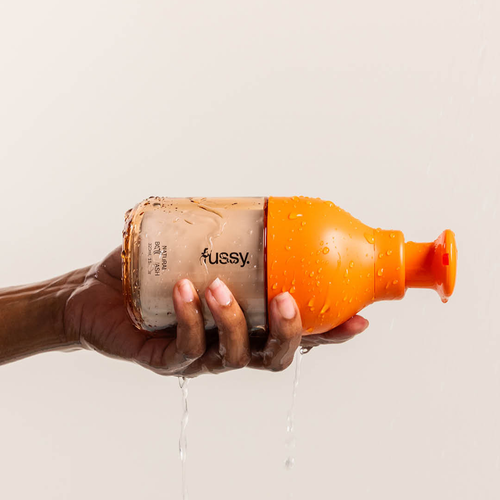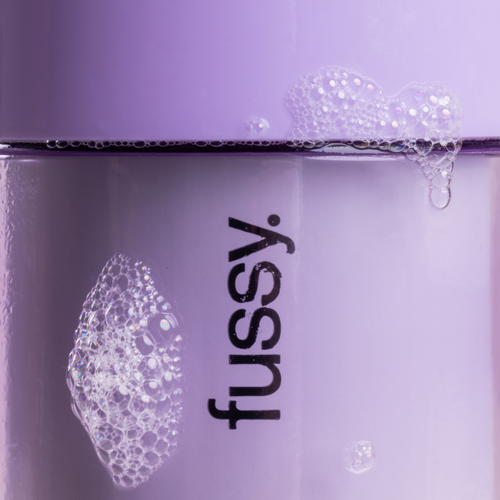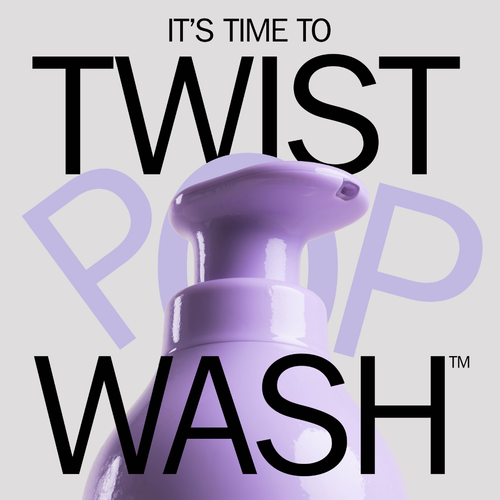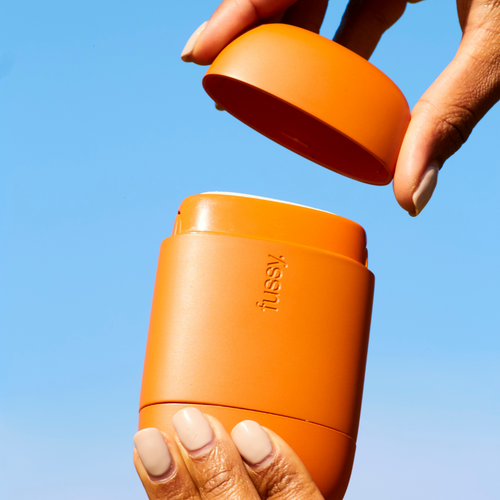When you think of plastic what comes to mind? A plastic bottle? Cheap plastic toys? A plastic bag? Most likely. But what about your favourite jumper? The teabag in your morning brew? A piece of chewing gum?
The problem with plastic is that it’s everywhere, and we mean everywhere. From the water we wash our clothes in, to the soil in which we grow our food, and even in the air. There’s no escaping the ubiquitous material but what do we really know about it?
Nowadays, we tend to take plastic for granted. We assume that all plastics are the same and can be easily recycled. However, this is far from the truth. So, what is the best way to deal with the plastic problem? To answer this we need to change the way we think about plastics and to do that we need to understand what we’re dealing with.
We’re here to re-introduce you to plastic, from its evolutionary history to its promising future and, of course, Fussy’s role in tackling the plastic problem.
When was plastic invented?
The history of plastic is slightly more complicated than you may have thought. This is because according to science plastic is made up of polymers, a very broad category that includes silicones and even DNA.
Technically, humans have been using naturally derived plastics way before you could have imagined. Picture medieval lanterns made with thin slices of animal horn and, even further back in history, rubber balls played with by the Olmecs in Mexico, and of course, there’s the rubber tree.
But the plastics we’re concerned with today are the manmade kind, which all started in the 1840s with Charles Goodyear and his “vulcanised” rubber (yes, like the tyres). This triggered a whole swathe of plastic inventions with more and more iterations of the stuff coming to market and, apparently, making life easier.
However, arguably the biggest breakthrough in plastic innovation came in 1907 with the invention of Bakelite by Leo Baekeland - the first synthetic plastic derived from fossil fuels. The key to Baekeland’s success was phenol, an acid derived from coal tar, and it was this magic ingredient that opened the floodgates to a wave of synthetic plastics.
From Bakelite, we now have polystyrene, polyester, polythene, nylon, PVC, PET, and Tupperware. But there are literally hundreds of thousands of different kinds of polymers that are used to make plastic products.
What is plastic actually made of?
As you can guess from our very brief history of plastic, understanding what plastic is made of isn’t any simpler. For the sake of this post, let’s focus on synthetic plastics as these are the nasty compounds polluting the planet. Apologies in advance for the chemistry class flashbacks.
Synthetic plastics are made using crude oil, natural gas, or coal - all of which are non-renewable fossil fuels (the baddies). Once the raw materials have been extracted (mostly crude oil), they will be refined into different petroleum products.
These products then go through a process called polymerisation, which is essentially converting monomers to polymers to form a long chain of molecules. That’s where we get the “poly” from polyethylene terephthalate, better known as PET.
To get the plastic that is used to make our shopping bags and milk bottle tops, a mixture of these synthetic materials is combined and turned into pellets. These pellets are then melted and put through an extruder or mould and are transformed into our familiar household objects.
So, what's the problem with plastic?
As you can imagine, when these kinds of plastics came around in the twentieth century it was revolutionary. Suddenly basic objects went from being fragile and expensive to durable and reasonably affordable.
But here enters the problem. Plastic is just a little too durable, in fact, it pretty much lasts forever. It could take thousands of years for just one plastic bag to decompose and what’s worse, the plastics that do seem to disappear are finding their way into our oceans.
Meet the microplastics
Although they’ve only recently come into the forefront of scientists minds, microplastics are branded as one of the greatest manmade disasters of our time. That’s because they’re everywhere, from the top of the Himalayas to the abyss of the Arctic, from the food we eat to the water we drink, there’s no escaping them.
Microplastics are literally that: small plastic. More specifically, anything that measures less than five millimetres. They form when plastic becomes fragmented due to natural processes like sunlight exposure, which makes the material brittle and easy to break.
But they don’t stop there. Microplastics can go on deteriorating until they become dust, or ‘nanoplastics’. This means that plastic is even in the air that we breathe.
Although this sounds scary, the question as to how harmful these tiny plastics are to human health is still contested. There’s no doubt that plastic isn’t good for us, but as to how severe the effects will be, that’s still uncertain.
Recycling to the rescue?
"What about recycling?!” we hear you cry. Well, the good news is that all those arguments with your partner over which bottle goes in what bin is not totally in vain. Recycling is a great tool in our arsenal of weapons to tackle climate change. But, there are a few things to keep in mind if you really want to make a difference.
- Pay attention. As you now know, there are loads of different kinds of plastic out there and they all vary in how (or even if) they can be recycled. In fact, many plastic products are single-use. So if you’re throwing your polystyrene in with your PET, you’re actually creating more pollution through the effort it takes to remove the unrecyclable plastic and get it to a landfill.
- It will always produce carbon emissions. Recycling uses a huge amount of water and energy to collect, transport, and process your waste. Plus, when it comes to plastic, recycling plants are very picky. Even if your yoghurt pot does get through all the checkpoints and is recycled, a load of energy would have been required to get it there.
- Ultimately, reuse is always going to beat recycle when it comes to plastic. As a material, it’s just much harder to recycle than glass or paper. But even with those materials, reducing your overall waste is always going to be the best option. So opt for refill wherever you can.
The future of plastic
So yeah, plastic is a pretty big problem but we’re not here to spread too much doom and gloom. Let’s shed some light on the future of plastic.
The synthetic plastics we know today are made using finite resources, that’s the good old fossil fuels. With resources running out, the industry is looking for alternatives for making the white gold, alternatives like bioplastics and even plastic-eating bacteria!
One of the most well-known bioplastics is PLA, a.k.a polylactic acid, a plastic substitute made from the renewable resource, corn starch. Sounds like a dream solution right? Unfortunately, it’s not so simple. Although it’s often touted as a biodegradable plastic, PLA needs to be industrially biodegraded and the farming of corn can take valued food from those people that need it most.
Also, when it comes to using PLA in a product, it’s just no match for synthetic plastics. When designing our Fussy deodorant case, we were determined to use totally renewable materials, however, using PLA would have meant a significant decrease in quality. We know because we tested it and for a product that’s meant to last, that’s something we couldn’t compromise on.
Instead, we use 50% recycled plastic for our refillable cases, which are made to last. But the goal is to move to 100% ocean-bound plastic when we can.
Plus, there are loads of fussy friends like us striving to bring plastic-free products to people and make tackling the plastic problem a little easier.
Is it time to put plastic in the bin, for good?
While we’re not here to defend plastic, we get it, going completely plastic-free isn’t easy. But if we want to see a future for our planet, there’s no doubt that reducing our consumption of plastic is the best way forward.
So what about all the stuff that’s already in our cupboards and in the shops? We, and many others, believe that the key to solving our plastic problem lies in the way we think about it. This means it’s time to start a #refill revolution!
If all beauty and personal care products offered a refill model, as well as home cleaning, packaging and transport savings would represent an 80–85% reduction in GHG emissions compared to today’s traditional single-use bottles.
Fussy alone provides an 81% reduction in carbon emissions compared to a standard single-use deodorant.
Plastic is an extremely valuable material, that’s a fact. It’s durable, multi-purpose, and affordable, and yet billions of kilograms of it end up in landfills every year.
Ultimately, we need to move away from this throw-away culture to a mindset that focuses on reusing, re-filling, and re-inventing the plastic that we already have. Only once we’ve altered how we think about plastic will we be able to really tackle the problem it poses.
In the meantime, Fussy is here to help everyone reduce their plastic waste, one fresh-smelling human at a time.






